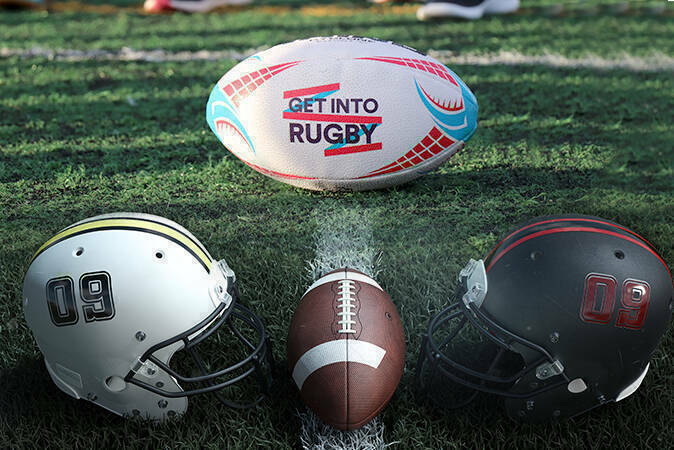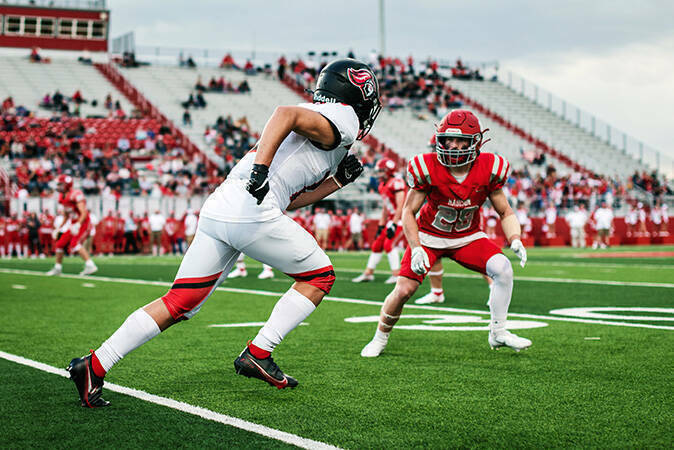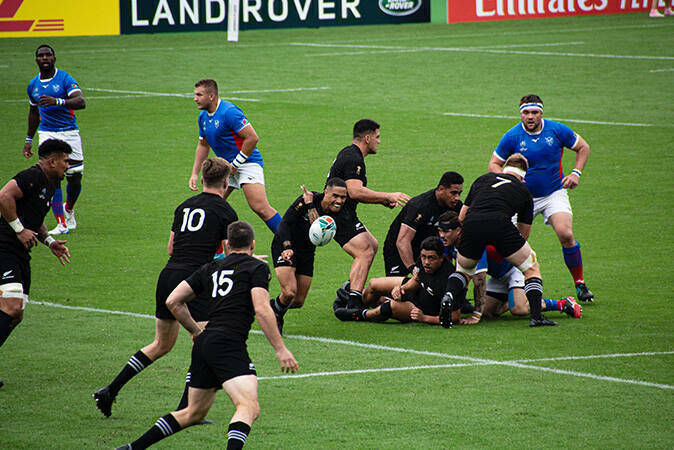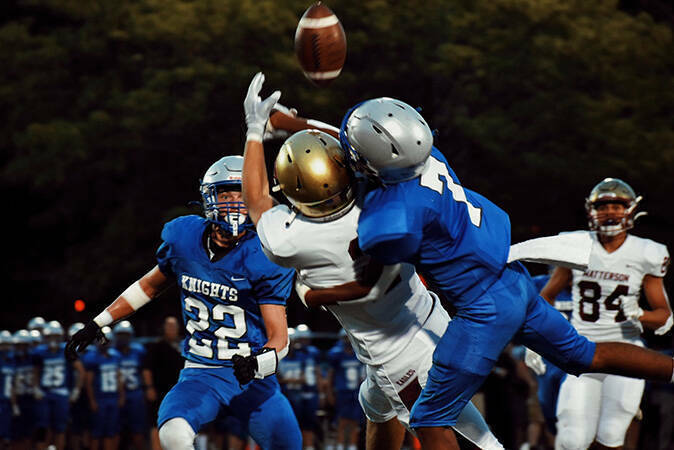The differences between rugby and American football

As the Super Bowl approaches, let’s review the basics…
Generally known to the general public thanks to the “Super Bowl Halftime Show”, American football is still an underrated sport in Europe. Indeed, despite the presence of many clubs on the old continent, the rules of this sport are still unknown to most of us. In addition, many take malicious delight in comparing it to rugby, two sports that are similar in certain aspects but very different in substance!
As the Super Bowl approaches, the uninitiated always ask the same questions about rugby and American football. If you are one of them, this article is for you!
What is the origin of these sports?
Officially recognized in 1823, rugby was born in England at the initiative of William Webb Ellis, a student at Rugby College. According to a popular anecdote, this discipline was created when William decided to pick up a ball and use it to cross the entire field in order to slam it into the goal of the opposing team during a soccer match. It is for this reason that the trophy of the biggest world competition (Rugby World Cup) bears his name.
Regarding American football, as its name suggests, this discipline was created in the United States several decades after rugby. It is estimated that it can be traced back to 1860, with the arrival of British settlers on American soil. At that time, rugby and soccer being the most popular disciplines in the country, Gerrat Smith Miller had the idea to combine them. As early as 1870, matches were played in some North American universities. A few years later, in 1920, the American Professional Football Association was born.
The object of the game…
In both disciplines, the objective is to gain ground in order to get closer to the end zone of the opposing team.
Several actions enable teams to earn points, and even if the rules differ, there are some similarities between the two disciplines:
The play that awards the most points entails passing into the opponent’s end zone with the ball. In rugby, it is a question of grounding the ball in the area to score a try (5 points). In American football, a touchdown (6 points) is achieved by penetrating the area with the ball, or by receiving a pass in it. These actions can be enhanced by a transformation, when the ball must be kicked between the two poles (in rugby +2 points, in American football +1 point). In American Football, you can also try for an “extra point”, which is a single attempt to get back into the in-goal zone and thus win 2 points.
As they try to gain ground, the teams are faced with a few rules. Speaking very simply, it should be noted that in rugby, all hand passes must be made backwards, so progression is either ball in hand or with a foot pass. In American football the attacking team has 4 attempts to progress by 10 yards. If they succeed, they have the right to a cycle of 4 attempts and so on until they attempt a touchdown. If they do not reach the 10-yard line after four attempts, the ball is given to the opposing team. To
make progress, the offensive team has the right to one pass per attempt, each play ending when the ball carrier is brought to the ground, or if the pass is incomplete.
There are other ways of winning points, notably by kicking. In rugby, 3 points are awarded when the ball goes between the goal posts, either after a foul by the opposing team (called a penalty), or during a phase of play by kicking the ball after bouncing it on the ground (called a drop kick). In American football, during the 4th attempt by a team, they can try to kick the ball between the goal posts to win 3 points.
Points are calculated as follows:
- In rugby : a try (5 points), a conversion (2 points), a drop goal (3 points), a penalty kick (3 points)
- In American football: a touchdown (6 points), extra points (1 or 2 points), a field goal (3 points), a safety (2 points for the opposing team)
The playing field…
Apart from the shape of the ball, another similarity that causes confusion between American football and rugby is the playing field. Even though they both have an end zone, the fields are different. The differences between the two are found in the size of the field and the goal posts. The goal posts in a rugby stadium are H-shaped, those of American football are Y-shaped.
As for the size of the rugby field, the dimensions are around 100 meters long by 70 meters wide. The unit of measure for American football is different. It is measured in yards, one yard being equal to 0.91 meters. The size of an American football stadium is 120 yards long, i.e. 109.2 meters, and 53.33 yards wide, i.e. 48.53 meters.
The rules of the game
The first difference is the duration. In rugby, playing time is set at a total of 80 minutes, with two 40- minute half times, compared with four 15-minute quarters for American football. These periods of play are followed by a 12-minute halftime after the first two quarters.
The second difference is the total number of players on the field. In rugby, the most common configuration is 15 players a side (there are versions with 13 and 7 players a side). In American football there a 11 players a side.
There is also a particularity concerning the number of replacements. For rugby, players play offensive and defensive phases, and only 7 changes can be made during the match. In American football, there is no limit to the number of replacements because the teams change almost entirely between the offensive and defensive phases.
Equipment…
The main item of equipment is the oval ball. Even though they have the same shape, the size of a rugby ball is around 27 cm compared with 28 cm for American football. Players also wear equipment to protect themselves during the game.
In rugby, players can wear flexible and non-obligatory thigh pads, helmets and gum shields. In American football, given the power of the impacts, players wear obligatory gum shields, more protective and rigid helmets, shoulder pads, and knee and elbow protection during the games.
Game technology
Despite all these differences, the two sports are quite similar in their relationship to technology. Numerous innovations have appeared on American football and rugby fields, and other sports have taken inspiration from this progress to make the game more fluid or to improve the spectator experience. Instant replay appeared from 1978 in the NFL and has developed considerably in order to increase the number of situations in which they can be used. In Rugby, beyond VAR, used since
the 2000s, it is the equipping of referees with microphones that has appealed to television viewers and other sports. In League 1, new broadcaster Amazon Prime equipped the referee team for St-Etienne – Monaco in April 2022. This action revived debate among the institutions, who wished to make refereeing more transparent with respect to the various stakeholders of the sport.
Beyond refereeing, we can note other fine technological progress made by our American friends. Communication between the players and their coaches is now performed via a microphone built into the quarterback’s helmet. This adds to the tablets that the League has provided on the sideline to analyze play in real-time. Lastly, we can mention several innovations to protect the physical health of players: A competition was organized by the NFL to redesign players’ helmets to limit concussions. The medical teams also have real-time access to players’ health data.
Business is business…
At the business level, the figures favor American football. Even if the sport finds it difficult to expand beyond the borders of the US, the NFL, and the Super Bowl (league championship game) in particular, enjoy colossal audiences and revenue compared with those of rugby. The next NFL broadcasting contract will cover 11 seasons (2023-2033) and will bring the League between 105 and 110 billion dollars, or nearly 10 billion per season.
Another figure that demonstrates American super power is the cost of an advertising spot during the Super Bowl halftime: advertisers pay 7 million euros for a 30-second commercial. At that price, advertisers necessarily demonstrate all their creativity in order to stand out…
As for rugby, there are some fine perspectives nonetheless, especially in France, which will host the next World Cup in September 2023. According to the organizer’s forecast, the competition should generate net profit of 68 million euros, which will be devoted to the development of rugby in France.
With all this information, you now have a few solid arguments for a debate among friends on rugby and American football.
Article written by Vanillie EKOUMA
Les autres articles
Retrouvez les autres Actualités Sport Business des campus AMOS
Découvrez nos formations
Un diplôme de niveau bac+5 est courant pour ce type de métier. Un bachelor associé à un master ou un Programme en 5 ans permet de développer des compétences diverses. En effet, en plus d’élargir ses connaissances sur le marché du sport, les étudiants se spécialisent dans le management, la communication et le marketing du sport.
















